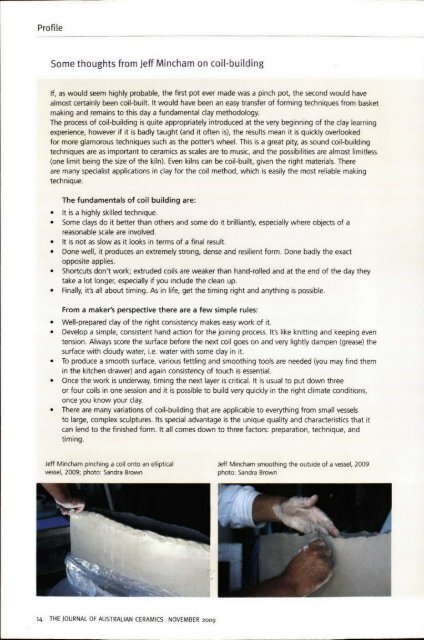The Journal of Australian Ceramics Vol 48 No 3 November 2009
Create successful ePaper yourself
Turn your PDF publications into a flip-book with our unique Google optimized e-Paper software.
Pr<strong>of</strong>ile<br />
Some thoughts from Jeff Mincham on coil-building<br />
If, as would seem highly probable, the first pot ever made was a pinch pot, the second would have<br />
almost certainly been coil-built. It would have been an easy transfer <strong>of</strong> forming techniques from basket<br />
making and remains to this day a fundamental clay methodology.<br />
<strong>The</strong> process <strong>of</strong> coil-building is quite appropriately introduced at the very beginning <strong>of</strong> the clay learning<br />
experience, however if it is badly taught (and it <strong>of</strong>ten is), the results mean it is quickly overlooked<br />
for more glamorous techniques such as the potter's wheel. This is a great pity, as sound coil-building<br />
techniques are as important to ceramics as scales are to music, and the possibilities are almost limitless<br />
(one limit being the size <strong>of</strong> the kiln). Even kilns can be coil-built, given the right materials. <strong>The</strong>re<br />
are many specialist applications in clay for the coil method, which is easily the most reliable making<br />
technique.<br />
<strong>The</strong> fundamentals <strong>of</strong> coil building are:<br />
• It is a highly skilled technique.<br />
• Some clays do it better than others and some do it brilliantly, especially where objects <strong>of</strong> a<br />
reasonable scale are involved.<br />
• It is not as slow as it looks in terms <strong>of</strong> a final result.<br />
• Done well, it produces an extremely strong, dense and resilient form. Done badly the exact<br />
opposite applies.<br />
• Shortcuts don't work; extruded coils are weaker than hand-rolled and at the end <strong>of</strong> the day they<br />
take a lot longer, especially if you include the clean up.<br />
• Finally, it's all about timing. As in life, get the timing right and anything is possible.<br />
From a maker's perspective t here are a few simple rules:<br />
Well-prepared clay <strong>of</strong> the right consistency makes easy work <strong>of</strong> it.<br />
• Develop a simple, consistent hand action for the joining process. It's like knitting and keeping even<br />
tension. Always score the surface before the next coil goes on and very lightly dampen (grease) the<br />
surface with cloudy water, i.e. water with some clay in it.<br />
• To produce a smooth surface, various fettling and smoothing tools are needed (you may find them<br />
in the kitchen drawer) and again consistency <strong>of</strong> touch is essential.<br />
• Once the work is underway, timing the next layer is critical. It is usual to put down three<br />
or four coils in one session and it is possible to build very quickly in the right climate conditions,<br />
once you know your clay.<br />
• <strong>The</strong>re are many variations <strong>of</strong> COil-building that are applicable to everything from small vessels<br />
to large, complex sculptures. Its special advantage is the unique quality and characteristics that it<br />
can lend to the finished form. It all comes down to three factors: preparation, technique, and<br />
timing.<br />
Jeff Mincham pinching a coil onto an elliptical<br />
vessel, <strong>2009</strong>; photo: Sandra Brown<br />
Jeff Mincham smoothing the outside <strong>of</strong> a vessel. <strong>2009</strong><br />
photo: Sandra Brown<br />
14 THE JOURNAL OF AUSTRALIAN CERAMICS NOVEMBER <strong>2009</strong>


















